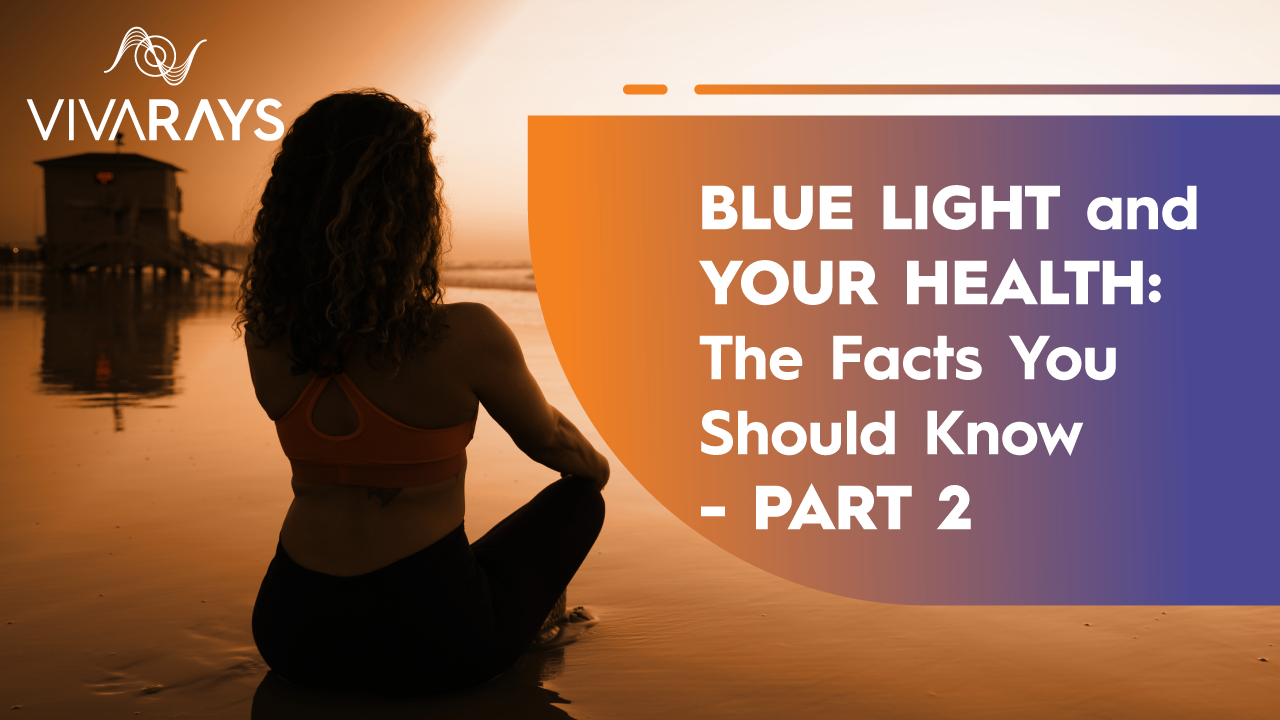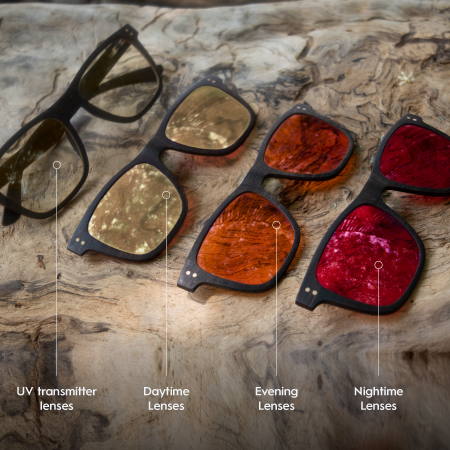Blue Light and Your Health: The Facts You Should Know - Part 2

Blue Light and Its Impact on Your Health: The Science Behind It
Are you someone who likes to use your phone or tablet in bed?
Maybe you watch TV or use a lamp to read before dozing off?
Well, did you know that these light-emitting electronics and sources of light can actually affect your sleep patterns?
Exposure to violet, blue and even green light (495–570 nm) after sunset has two primary effects:
Melatonin suppression and phase shifting which delays your clock. This delay can result in a desire to go to bed later and wake up later.
Let me explain...
Our bodies are wired to respond to light, especially the light that comes from the sun.
When the sun sets, our bodies start producing a hormone called melatonin. This hormone helps regulate our sleep patterns and makes us feel drowsy.
But when we expose ourselves to artificial light at night, especially violet and blue light, our melatonin production gets disrupted.
Think of it like this: melatonin is the chemical expression of darkness.
When it's dark outside, our bodies naturally produce melatonin to help us sleep. But when we expose ourselves to artificial light, we disrupt this natural process.
It's like trying to fall asleep at noon on a bright, sunny day – it's hard to do!
Studies have shown that even room light can reduce pre-sleep melatonin levels by 71.4 percent and daily melatonin levels by 12.5 percent.
And this effect is even greater in children than adults. So, if you have kids, it's especially important to make sure they're not exposed to light before bedtime.
Now, you might be wondering why violet, blue, and green light have the worst effects on melatonin production.
Well, it's because these wavelengths have the highest energy and they are very rich during the day.
The higher the frequency, the more energy it carries, the more it suppresses melatonin. On the other hand yellow, orange, and red have almost no effect on melatonin.
But it's not just about the color of the light – it's also about how intense it is (brightness).
Lux is a term used to describe the total amount of visible light present and its intensity on a surface. The higher the lux, the more intense the light source.

Complete darkness is like zero lux.
So, imagine a night with no full moon – that's only 0.002 lux! And get this – a regular living room light is 2,499,900% brighter than a moonless night!
Crazy, right? No, seriously, that number is not a typo.
When you combine high lux values with violet, blue, and green light, you get a potent cocktail that can disrupt your sleep patterns.
So, what can you do to protect your melatonin levels?
Well, one solution is to use high-quality circadian light harmonizing glasses.
For example, the evening circadian light harmonizing glasses from VivaRays block 100% of the violet and blue light and decrease the intensity of light by 4 times.
On the other hand, the nightime circadian light harmonizing glasses block 100 % of the violet, blue and green light up to 570 nm (the melatonin disrupting zone) and decrease the brightness by 15 to 20 times.

The X-axis is the wavelength of light.
The higher dots represent a higher melatonin suppression. As you can see, blue light (400-500 nm) has the worst effects, however green light (500-570nm) also has a significant effect on melatonin suppression.
Wearing the evening glasses after sunset and switching the nightime glasses 1 hour before bed will help preserve your melatonin levels and keep your sleep/wake cycles in order.
Studies have shown that wearing blue-blocking glasses can make a big difference in melatonin production, especially compared to clear lenses.
Keep in mind: most of those studies only look at glasses that block 80-90 %violet and blue (and very little green light ).
We would expect high-quality circadian light harmonizing glasses that block 100% of all violet, blue and green and additionally decrease the brightness by 15-20 times to have even a lot more benefits.
To sum up, it's important to pay attention to the light you expose yourself to before bedtime.
Just like how you wouldn't try to sleep at noon on a sunny day, you shouldn't expose yourself to intense, blue light before bedtime.
So, put down your phone, turn off your TV, and let your body produce that melatonin – your sleep patterns will thank you for it!
Protecting Yourself from Blue Light: Tips and Strategies to Optimize Your Circadian Rhythm
Have you ever noticed how the light around you affects your mood and energy levels?
It's not just your imagination - light actually has a huge impact on our bodies, down to the genetic level.
In fact, we're so sensitive to light that just a single pulse of the wrong kind of light can throw off our sleep/wake cycles, a process called phase shifting or re-tuning.
Think of it like resetting the hands on a clock - if they're not in the right position, everything gets thrown off.
Similarly, if our circadian rhythm is thrown out of whack by light exposure, it can have serious consequences for our health and well-being.
Have you ever wondered how long it takes for artificial light to mess with your genes? Days, weeks, months, years, maybe? Well, I hate to break it to you, but it doesn't take that long!
Your body's cells are closely connected to time, and the most potent environmental cue for time is light.
In fact, we are so wired to detect light that we can sense a single photon! Shocking, right?
And get this: just one night of disrupted sleep from artificial light can throw off your body's CLOCK genes and mess with your gene expression.
So, next time you're tempted to stay up late binge-watching your favourite show, you might want to think twice about the genetic consequences!
But don't worry, there are ways to combat this phase shifting. For example, blue-blocking glasses can help preserve melatonin and normalize our circadian rhythm by stopping the 380-570 nm range of light. And sunlight during the day can also help
That’s exactly what Environmental Health Perspectives published:
‘’When people are exposed to sunlight or very bright artificial light in the morning, their nocturnal melatonin production occurs sooner, and they enter into sleep more easily at night.’’
However, it's important to note that not all light during the day is beneficial.
Sunlight has a balanced spectrum that we've evolved to live under for 200,000 years, but artificial light can vary widely in its composition.
In fact, research shows that when groups are exposed to daytime artificial light sources that are balanced (blue balanced with orange and red light) VS light sources that emphasize primarily blue (led bulbs and screens), the more balance light group has circadian rhythms that more closely match the rising and setting of the sun, whereas the unbalanced blue light group gets entrained to unnatural rhythms.
It's clear that light plays a critical role in our lives, down to the genetic level.
So the next time you're exposed to a bright screen or harsh artificial light, think about how it might be affecting your body's clock - and consider taking steps to protect yourself from its harmful effects.
Take Control of Your Health by taking control of the light that enters your eyes
Your eyes are incredible organs that can detect the visible portion of light, but they can't see ultraviolet or infrared light.
You may remember learning about the rods and cones in your retina, which take in light and turn it into signals for your brain.
However, there's an important area called the retinal pigment epithelium (RPE) that helps protect these cells from damage.

Think of the RPE as a superhero that saves the day.
It doesn't actually start the process of turning light into signals, but it protects the molecules that do.
Without RPE, you could develop diseases like macular degeneration and eventually lose your sight.
Now, let's talk about blue light. Some blue light, especially around the 480 nm range, is essential for our well-being. It helps set our circadian clock and improves our sleep quality and hormone responses.
However, too much blue light can be harmful to our eyes, particularly the RPE cells.

RPE cell (death) is greatest in the 420–455 nm range
As you can see in the above chart, violet and the beginning of the blue spectrum have an extremely phototoxic effect, which can lead to the death of RPE cells.
This is particularly true when the blue and violet light is not balanced and proportionate with the orange and red light, like in the case of artificial LED bulbs and screens
Protect Your Eyes and Brain from the Damaging Effects of Blue Light on DHA
Let's talk about how blue and violet light can impact our body's ability to absorb and use a fatty acid called DHA.
DHA is really important for maintaining healthy cells in our retina, which is part of our eye that allows us to see.
Photoreceptor cells in the retina actually have the highest concentration of DHA of any cell in our body.
And the thing is, RPE cells are responsible for protecting those photoreceptor cells and consuming DHA.
So if blue and violet light damage the RPE cells, it can also harm our body's DHA stores.
Why does this matter? Well, DHA is a really special fatty acid that has been important in animal evolution for over 600 million years!
Research has shown that maintaining high levels of DHA can help with conditions like high blood pressure and can even increase the energy available for our cells to use.
And since the retina has the highest concentration of DHA in our body, it makes sense that keeping those levels topped off can help prevent conditions like macular degeneration (eye disease that can blur your central vision).
DHA also plays a fundamental role in our ability to convert light into electricity.
It all starts with proteins like rhodopsin that convert light into electrical signals in the retina, which then talk to the SCN (suprachiasmatic nucleus) in the brain to regulate our sleep-wake cycle.
But here's the kicker: blue light, which is abundant in our tech devices, can actually bleach the majority of rhodopsin, especially at night when our photoreceptors are more vulnerable.
On the other side, DHA enhances and protects rhodopsin, thereby supporting a healthy circadian rhythm.
And what better way to maintain those DHA levels than by wearing glasses that help harmonize the circadian light we receive from our environment, like the Vivarays Circadian Light Harmonizing Glasses?
By filtering out harmful blue light and supporting healthy DHA levels, these glasses can help promote better sleep and overall wellness.
Also, Seafood is actually the best source of DHA because it's less prone to oxidation and is better absorbed by our bodies.
Try incorporating more fish into your diet or consider taking a high-quality fish oil supplement.
Taking care of our eyes and our body's overall health is really important, and making small changes like wearing Vivarays circadian light harmonizing glasses and incorporating more fish into our diets can make a big difference.
Once your circadian rhythm is optimized, everything else becomes easier. Being healthy is easy. You just need to give your body the right environment. And that's start with healthy light.




Leave a comment